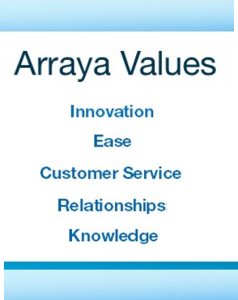 They say you can’t go home again, but Arraya did our part to disprove that theory with our 5th Annual Open House and Technology Day. After two years of hosting the event at an off-site venue, we brought our yearly event back to the friendly confines of our corporate headquarters andthe homecoming was a great success. As has become par for the course at our Open House, attendees had the opportunity to discuss the present and the future of the tech industry, network with their peers and enjoy some great food and drink in the process.
They say you can’t go home again, but Arraya did our part to disprove that theory with our 5th Annual Open House and Technology Day. After two years of hosting the event at an off-site venue, we brought our yearly event back to the friendly confines of our corporate headquarters andthe homecoming was a great success. As has become par for the course at our Open House, attendees had the opportunity to discuss the present and the future of the tech industry, network with their peers and enjoy some great food and drink in the process.
The event, which was catered by Victory Brewing Company, took place in a large tent set up in our parking lot. It had a fall theme which was evidenced by the pumpkins and jars of candy corn dotting the scenery.
Arraya’s CEO Daniel Lifshutz kicked things off with a welcome address covering some of Arraya’s 2015 highlights as well as some of the shifts he’s observed in the industry since co-founding the company back in 1999.
“We’ve been in business now for 16 years. We’ve seen a lot of different trends. Some of them changed the way we do business and changed the way our customers do business. Some trends didn’t work out so well,” Lifshutz said. “Through it all, it’s always about the relationships for us. The people in this room today, the partners, the customers, they give us a reason to wake up every morning and do what we do.”
In his address, Lifshutz also broke some big news. He officially unveiled the date of Arraya’s second Tech Summit: June 9, 2016. The Tech Summit debuted this past summer and featured a full day of breakout sessions and panel discussions lead by Arraya’s industry-leading team of engineers. It provides customers with a chance to learn about the latest IT solutions directly from some of the people who know them best.
Following the announcement of the date, Lifshutz invited attendees to complete a brief survey concerning the tech topics they foresee being most significant to their organization in the coming year. These answers will be used to help formulate the course list for the upcoming Tech Summit, ensuring the event maintains a “by techs, for techs” mentality. Attendees who filled out the survey were entered into a drawing and two winners were selected. One took home a pair of tickets to a Philadelphia Flyers game, the other won a pair of Philadelphia 76ers tickets.
Just as with past Open House events, a local celebrity was on hand to rally the crowd, impart some wisdom, pose for pictures and sign a few autographs. This year’s special guest was Sal Paolantonio, an NFL correspondent for ESPN, author, journalist and local radio personality. Paolantonio led a lively discussion with guests about football, the prospects of the Philadelphia Eagles and more.
After the group discussion wrapped, Paolantonio stuck around to chat with guests one-on-one, raffle off copies of one of his books, “Frank Rizzo: The Last Big Man in Big City America,” and even toss around a football.
The day’s giveaways didn’t end with the tickets and books. Arraya also sponsored a social media contest to encourage attendees to spend a little time tweeting about the day. The rules were simple: whoever tweeted the most using the official Open House hashtag (#ArrayaOpenHouse) would win a GoPro camera. To encourage participation, selfie sticks were scattered around the tent.
The allure of the GoPro and the easy access to selfie sticks did the trick, setting off a flurry of tweets. By the time a winner was announced at the end of the night, 249 tweets were sent using #ArrayaOpenHouse. The winner of the GoPro tweeted 79 times during the event.
Arraya’s partners were also well-represented at the Open House. On top of all of the other festivities, there were video demos from Microsoft, VMware, Cisco, EMC and VCE. Microsoft also brought along its device bar to give visitors a chance to see some of its latest tools and tech up close and personal.
If you weren’t able to attend, check out our Twitter feed, @ArrayaSolutions, or our Facebook page to see pictures from the event. Also, visit our News and Events page for a full list of the events and learning opportunities coming down the road from Arraya!
 hardware, infrastructure and software applications used to manage data. Meanwhile, OT concerned itself with the devices and real time processes that occurred on the plant floor. As more devices connect thanks to IoT, this separation becomes less acute.
hardware, infrastructure and software applications used to manage data. Meanwhile, OT concerned itself with the devices and real time processes that occurred on the plant floor. As more devices connect thanks to IoT, this separation becomes less acute. may be enough for some, seasoned IT pros know the threat of sensitive data falling in the wrong hands is where the real scares lie. After all, only one of those can end in hefty fines, upset customers or employees and mountains of bad PR.
may be enough for some, seasoned IT pros know the threat of sensitive data falling in the wrong hands is where the real scares lie. After all, only one of those can end in hefty fines, upset customers or employees and mountains of bad PR. we’re not just trying to scare you. We also have some ideas on how to address the challenges presented by those statistics.
we’re not just trying to scare you. We also have some ideas on how to address the challenges presented by those statistics.

 one year, a lot. Secondly, Microsoft has decreased the amount of time it takes to roll out a customer-requested update. This has resulted in a good amount of changes that you may or may not know about.
one year, a lot. Secondly, Microsoft has decreased the amount of time it takes to roll out a customer-requested update. This has resulted in a good amount of changes that you may or may not know about. easier management of identities across platforms. Customer impressions differ from reality though. Even with a good partner message, some customers forget about the benefits and begin to ignore DirSync entirely. This can lead to two things. First, DirSync becomes mismanaged and account issues are not remediated. This often leads to the second thing, which is that the customer turns off DirSync and develops a hodgepodge of processes to manage accounts in the cloud.
easier management of identities across platforms. Customer impressions differ from reality though. Even with a good partner message, some customers forget about the benefits and begin to ignore DirSync entirely. This can lead to two things. First, DirSync becomes mismanaged and account issues are not remediated. This often leads to the second thing, which is that the customer turns off DirSync and develops a hodgepodge of processes to manage accounts in the cloud. employees connect to organizational networks, from where they’re able to connect, and the devices they use to do so.
employees connect to organizational networks, from where they’re able to connect, and the devices they use to do so. been tougher to lock down with policies has been the corporate network. Often this stems from poor visibility into the network itself, a misalignment of IT and the rest of the business or a lack of flexibility in today’s always evolving corporate world. However, if recent trends continue to hold – and there’s every indication that they will – stronger, more business-focused
been tougher to lock down with policies has been the corporate network. Often this stems from poor visibility into the network itself, a misalignment of IT and the rest of the business or a lack of flexibility in today’s always evolving corporate world. However, if recent trends continue to hold – and there’s every indication that they will – stronger, more business-focused